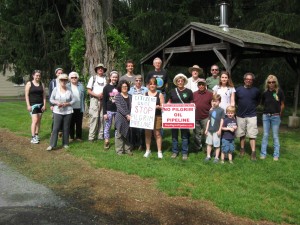Protest hike in the New Jersey Highlands against the Pilgrim Oil Pipeline
By Alexander Schlutz
A group of concerned New Jerseyans met this past Sunday morning for a hike in the Ramapo Valley County Reservation to protest the proposed Pilgrim oil pipeline. If constructed, the pipeline would pump 400,000 gallons of crude oil per day from the Bakken formation that underlies parts of Montana, North Dakota, Saskatchewan and Manitoba through several New York and Jew Jersey communities, as well as the dense forests of the New Jersey highlands.
Ken Dolsky of the Coalition Against Pilgrim Pipeline led the group on a three-mile hike up to a pumping station and a roughly fifty-feet-wide cut on the mountainside for the already-existing Spectra Energy natural gas pipeline, which bisects the forest like a ski-slope. (While there is no skiing atop the pipeline, the clear-cut swaths that criss-cross the Ramapo mountains prove irresistible in spring and summer to dirt-bikers, who careen illegally up and down the mountain like buzz-saws on wheels.) The Pilgrim pipeline, should it be built, would be added to the Spectra pipeline, using the existing “right of way.”
The group of hikers, which included two founding members of the North Jersey Pipeline Walkers, took a trail that first crossed the Ramapo River at the valley floor, and later Havemeyer brook further up in the forest. Ken Dolsky had chosen the route specifically to demonstrate the pipeline’s connection to the area’s streams. On previous hikes, members of the coalition had counted fourteen smaller creeks that would be crossed by the pipeline’s proposed route, all of which feed into Havemeyer brook, which in turn feeds into the Ramapo river at the bottom of the valley. Any spilled or leaked oil from the pipeline would inevitably contaminate the whole interconnected water system, with potentially devastating consequences not just for the natural environment but also for the human communities that depend on it: The Ramapo river, as Elliott Ruga from the New Jersey Highlands Coalition pointed out, also feeds into the area’s municipal water wells.
Ruga, who gave a brief talk to the group at the mid-way point of the hike below the pumping station, expressed additional ecological concerns. Adding another pipeline to the existing ones – in addition to the Spectra pipeline, the Tennessee Gas Pipeline (TGP), an 11,900-mile pipeline system that transports natural gas from Louisiana and Texas to the East Coast also runs through the Ramapo mountains – would inevitably require widening the existing cuts, impacting the forest eco-system in ways that would radiate out for miles in both directions (linear developments and the fragmentation they cause affect the non-linear and interconnected natural systems in ways that go far beyond the immediate site of the bisection itself). The core forests of the New Jersey highlands are crucial filters for the region’s water, an invaluable natural resource for the whole state. Astonishingly, despite its extremely dense population, New Jersey has the fourth-lowest cost of water in the U.S., Ruga remarked, due to the abundance of clean drinking water the highland region provides. Because of the close connection between forests and water, any disturbance of the North Jersey forest eco-system will have effects on the region’s water as well, which would be threatened not only by potential spills from the proposed pipeline, but by the building of the infrastructure as well.
The usual, myopic cost-accounting for fossil-fuel infrastructure projects does not take such larger ramifications and their effects on crucial “eco-system services” into account and is hence bound to be misleading. While the Highlands Water Protection and Planning Act of 2004 protects the natural environment of the region from further development, the act includes exemptions for utility upgrades to the already existing pipeline infrastructure. (The Spectra pipeline was laid decades ago.) Because the proposed oil pipeline would use the existing “rights of way,” Pilgrim’s logic goes, the new pipeline should qualify as such an upgrade. Whether that logic will hold remains to be seen. So far, Pilgrim has not yet filed for a permit with the New Jersey Department of Environmental Protection, and the project has already run into difficulties because PSE&G has refused to let Pilgrim use its infrastructure for a stretch of the proposed route. If Pilgrim cannot find an alternative for that portion of the route, the project may self-destruct before the permitting process has even begun. Grassroots activists like Dolsky and Ruga do not take that outcome for granted, however, and Sunday’s hike was part of an effort to get ahead of the curve, raise public awareness, and to make sure everything is done to prevent crude oil from finding its way into the Ramapo mountains. New Jersey municipalities to the south, like Chatham and Madison, which have already passed resolutions against the pipeline, are also doing their part.
